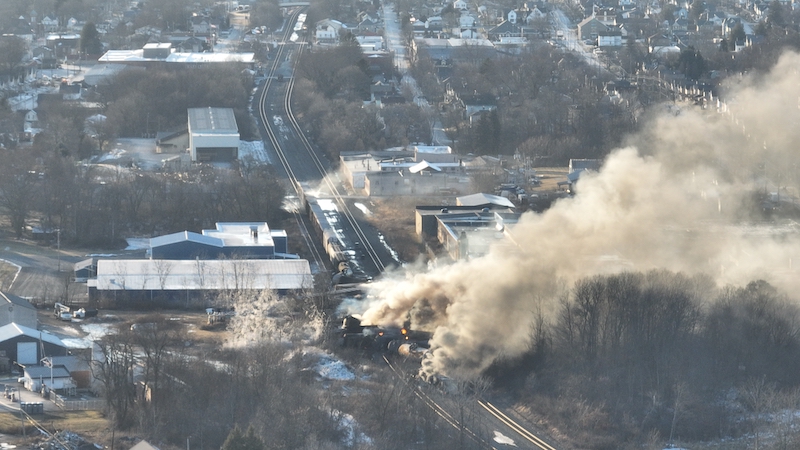Updated: Feb. 23, 6 p.m.
By Justin Franz
The National Transportation Safety Board confirmed what many people have believed about the explosive February 3 wreck of Norfolk Southern train 32N: It was caused by a hot bearing.
On Thursday, federal investigators released their preliminary findings in the examination of the derailment of 32N at East Palestine, Ohio. The report found that the temperature of the bearing in question had been slowly increasing for 30 miles before reaching East Palestine, but that when it reached NS’ threshold to actually stop and inspect the train, it was too late.
For the last few weeks, video from a security camera down the line has been circulating in the media and online showing one of the freight cars visibly on fire. According to the NTSB, three hot bearing detectors (also known as hot box detectors) recorded temperature increases on the bearing in question over the course of 30 miles, but only the third reading triggered an alert to stop and inspect.
At Milepost 79.9 on the Fort Wayne Line, the twenty-third car’s axle had a recorded temperature of 38 degrees above the ambient temperature. When it passed the next detector at 69.01, it had increased to 103 degrees. Finally, at Milepost 49.81, on the east side of East Palestine, the recorded temperature was 253 degrees above ambient. That triggered an audible alarm over the radio informing the crew to stop the train. The engineer began to slow the train, but by then it was too late. The axle failed and the car derailed. An automatic emergency brake application was initiated and the train came to stop. The crew reported to the Cleveland East dispatcher that their train was on the ground and on fire. The crew applied handbrakes on two cars at the head end of the train, uncoupled the power and moved it about a mile away.
NS has established the following hot bearing detector alarm thresholds and criteria for bearings, according to the NTSB.
-
Between 170°F and 200°F, warm bearing (non-critical); stop and inspect
-
A difference between bearings on the same axle greater than or equal to 115°F (non-critical); stop and inspect
-
Greater than 200°F (critical); set out railcar
The NTSB’s preliminary report comes as pressure builds on NS and the industry as a whole to prevent future incidents like what happened in East Palestine. In recent weeks, federal officials have been calling for more regulation to keep the industry in check.
Shortly after the NTSB released its report, the Association of American Railroads issued this statement: “NTSB’s deliberate and methodical approach under these challenging circumstances has been essential to establishing independent, credible findings into the cause of the accident in East Palestine. As an industry, railroads will use this initial report in shaping a thoughtful, fact-driven approach to prevent another similar accident before it can occur elsewhere,” write AAR President and CEO Ian Jefferies. “As stakeholders review this preliminary report, the railroads will continue to follow this ongoing investigation closely and look forward to reviewing NTSB’s final report. We share a singular mission of taking meaningful steps to further improve safety.”
Meanwhile, union officials said it was time to toughen regulations on the railroads. Brotherhood of Locomotive Engineers and Trainmen (BLET) National President Eddie Hall said the industry should not wait for the final NTSB report — which is likely a year or more away — to make changes. He was specifically critical of the desire by Class Is to run longer trains with fewer people.
“We were very fortunate this time that there were three crew members on this train. They were able to respond to the emergency, uncouple the locomotives from the train cars and take other action. If this had been a train operated by one crew member it may have taken longer to react to the fire caused by the failure of the bearings, axles and other mechanical items. It’s not unusual for things to go wrong on trains and sometimes many things,” Hall wrote. “This is why it is important to have experienced engineers and conductors onboard. But, despite running ever longer trains that routinely carry hazardous materials, railroad CEOs have pushed for having only one person on the train and to even use remotely-operated trains. This is a serious mistake.”



